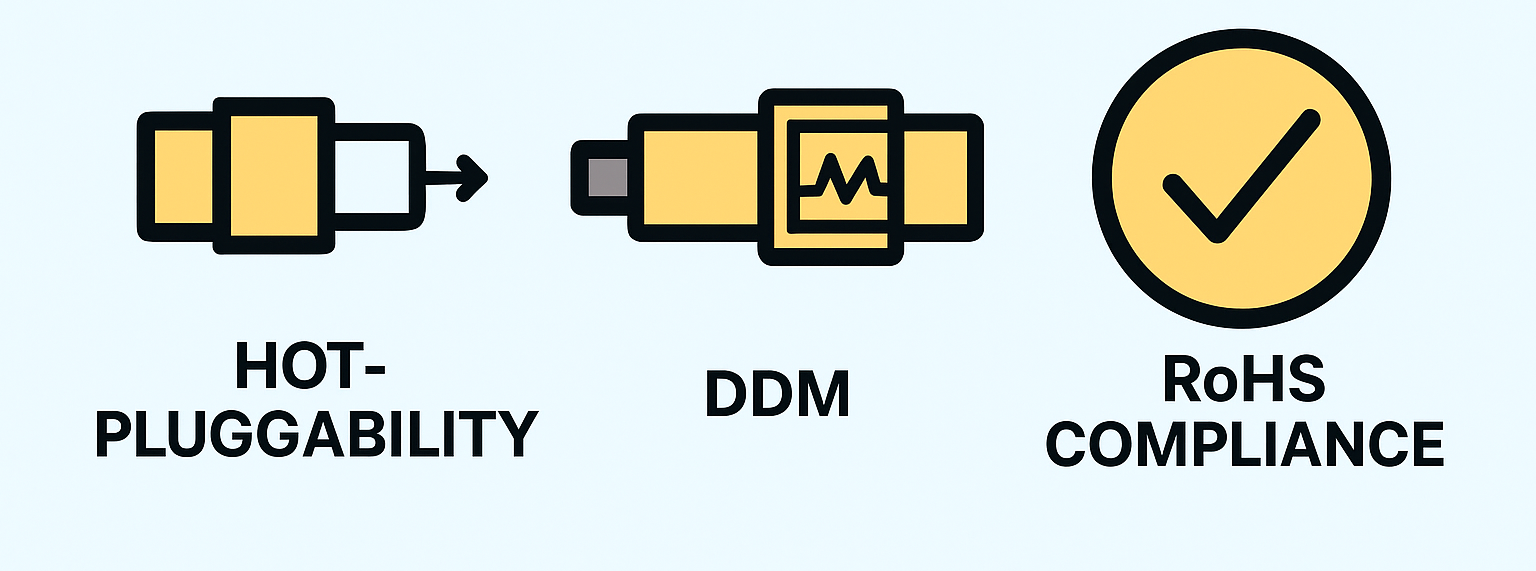Optical transceivers are the backbone of modern networking, powering high-speed data transmission across enterprise, telecom, and data center environments. While specifications like speed, distance, and wavelength usually take center stage, features such as hot-pluggability, Digital Diagnostics Monitoring (DDM), and RoHS compliance play a vital role in ensuring reliable, safe, and sustainable network operations.
In this post, we break down what these terms mean and why they matter when choosing an optical transceiver.

🔌 What is Hot-Pluggability in Optical Transceivers?
Hot-pluggability refers to the ability to insert or remove an optical transceiver into a switch, router, or media converter without shutting down the system.
Benefits of hot-pluggable transceivers include:
- Reduced downtime – No need to power down devices during installation or replacement.
- Flexibility – Network upgrades and maintenance can be performed seamlessly.
- Scalability – Easy to expand networks as demands grow.
This feature is standard in SFP, SFP+, QSFP, and other modular transceivers, making them highly convenient for dynamic networking environments.
📊 What is DDM (Digital Diagnostics Monitoring)?
Digital Diagnostics Monitoring (also known as DOM) allows real-time monitoring of critical parameters in an optical transceiver.
Key metrics monitored by DDM include:
- Optical transmit (Tx) and receive (Rx) power levels
- Module temperature
- Supply voltage
- Laser bias current
Why it matters:
- Proactive maintenance – Network engineers can detect issues before failures occur.
- Improved reliability – Helps maintain consistent optical performance.
- Lower costs – Reduces downtime by allowing predictive maintenance.
In short, DDM adds intelligence to your optical transceivers, making them easier to manage in high-performance networks.
♻️ What is RoHS Compliance in Optical Transceivers?
RoHS stands for Restriction of Hazardous Substances, a directive adopted in the EU and widely followed globally. It restricts the use of hazardous materials like lead, mercury, cadmium, and certain flame retardants in electronic equipment.
Why RoHS compliance matters:
- Environmental safety – Reduces harmful waste in landfills.
- Workplace health – Safer for installers and technicians handling the equipment.
- Global trade – Many regions (including the EU, US, and parts of Africa) require RoHS-compliant products for import.
When you see RoHS Compliant on an optical transceiver, it means the product meets strict environmental and safety standards.
✅ Final Thoughts
When evaluating optical transceivers, don’t just focus on speed and distance. Features like hot-pluggability save time, DDM provides visibility and control, and RoHS compliance ensures you are using environmentally responsible equipment.
At CrossLink™, we provide a wide range of SFP and SFP+ optical transceivers that combine performance, flexibility, and compliance — helping ISPs, enterprises, and data centers in Kenya and beyond build future-proof networks.

